With severe internal diseases, poor nutrition, as well as with age, nail growth slows down, its structure undergoes changes. Only a doctor can accurately determine the cause of the violation based on the results of microscopic tests and examinations.
But to get an idea of what happens to toenails or fingernails, you can use the picture with fungal diseases of different types.
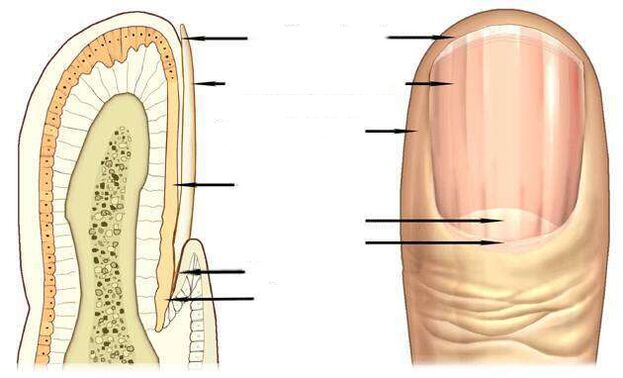
Causes of nail deformation
Molds, yeast-like fungi and dermatophyte fungi cause infectious nail diseases (onychomycosis), which show similar symptoms.All kinds of toenail fungus or toenails deform the nail plate, change its transparency, gloss, color, this variety can be seen in the photos presented.
Nail changes occur not only with onychomycosis, but also with lesions, chronic paronychia (inflammation of the nail fold), psoriasis, hand eczema, dermatitis. Before concluding that there is a fungal infection, you should consider all possible options.
Signs of a fungal infection
The most informative signs of fungal infection are changes in the color of the nail plate, the presence of nail detachment, superficial changes - transverse grooves, longitudinal in the nail plate, point depressions, thickening, destruction of the nail.
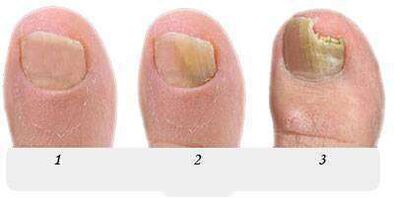
The pink color of a healthy nail is determined by the transparency of the nail plate and the blood vessels visible through it. With onychomycosis, the nail loses its transparency, the color becomes brown, yellow, less often green, black.
Candida fungi and dermatophytes cause onycholysis - the separation of the affected part of the nail. When infected with dermatophytes, onycholysis is observed from the distal edge of the nail and when infected with Candida, the nail remains behind the nail bed at the base, in the crescent area.
A symptom of a Candidale fungus may be inflammation of the lateral periungal ridges - paronychia. This disease has bacterial forms caused by streptococci and staphylococci, as well as non-infectious ones - eczema, psoriasis, systemic vasculitis.
When toenails are affected by the Trichophyton rubrum fungus, the plaque is affected, as you can see in the picture, the roller is not affected by the infection. The plaque becomes yellow, thickens strongly, the accumulated masses of fungi are well discernible beneath it.
Nail fungus due to dermatophyte infection
In 95% of all nail fungus cases, the disease is caused by dermatophytes Trichophyton rubrum and Trichophyton mentagrophytes.
Trichophyton rubrum infection
distal-lateral formTrichophyton rubrum dermatophyte fungal infection is common. In the picture, you can see that the stain caused by the introduction of the fungus is located along the lateral fold of the periungual nails.
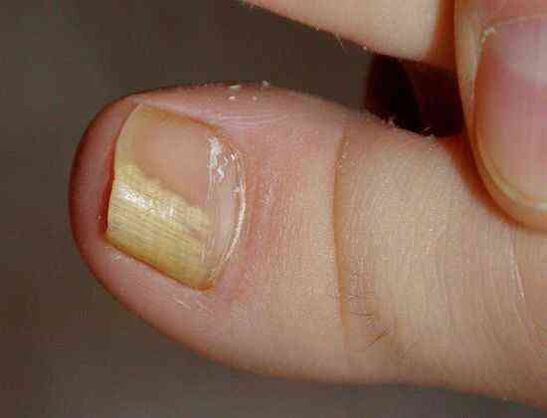
The fungus Trichophyton rubrum, as a rule, affects the big toes, causing hyperkeratosis - an accumulation of fungus between the nail plate and the nail bed, which looks like a free mass of yellow.
At this stage, the fungus occupies an insignificant part of the nails, as in the picture shown, and with the help of local treatment it is possible to cope with the initial onychomycosis.
Without treatment, the stain grows, gradually affecting the entire edge of the nail and then moving to the middle of the moon. In the photo, the nail fungus looks like yellow streaks directed towards the nail plate growth area.
With thedistal form of nail fungus, which is often found on the big toes, a yellow spot of infection appears on the extreme edge of the nail, in its central part, ascan be seen in the picture.
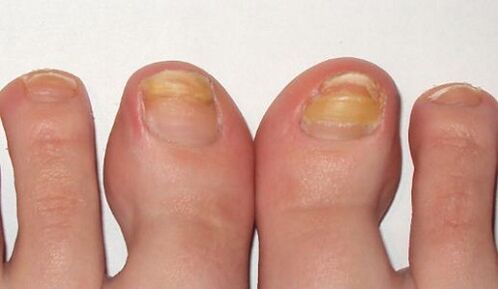
In the advanced stage of foot fungus, some nails are affected, as in the picture, and the treatment is no longer limited to local remedies and pills. In addition to antifungal medications, the nail is subjected to equipment cleaning, to remove the nail plate completely or partially.
Long-term therapy with the use of all known antifungal agents and treatments will be performed on the foot, caused by Trichophyton rubrum, with hyperkeratosis, as can be seen in the picture.
Fungal infection with total nail damage spreads to the entire area of the nail plate, the nail is completely destroyed.
Infection with another dermatophyte representative, the fungus Trichophyton mentagrophytes, can also lead to a total fungal infection of the nail.
Trichophyton mentagrophy infection
With a total defeat of the toenails with the fungus Trichophyton mentagrophytes, the nail plate is deformed, the photograph shows that it thickens, changes its structure, collapses, yellow spots all over its surface.
Nail infection with this dermatophyte usually causes superficial white onychomycosis of the thumb, less frequently of the little finger.
This fungus practically does not occur on fingernails, often causes interdigital dermatophytosis of the feet, as in the picture, and requires simultaneous treatment of the skin of the feet and nails.
A symptom of a fungal infection of the nails, usually on the feet, are white spots of various sizes, as in the picture, reminiscent of leukonychia - a disease of the nail plate itself.
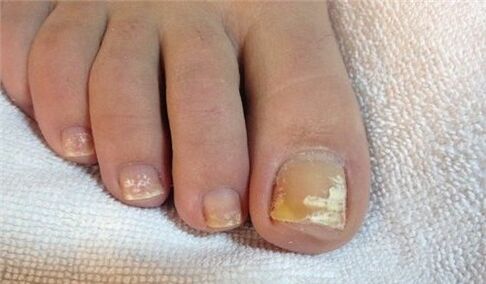
But unlike leukonykia, in which white spots are caused by the appearance of air bubbles in the nail layers, white spots in a fungal infection are the result of the activity of Trichophyton mentagrophytes.
Rarely, superficial white onychomycosis is caused by mold; in AIDS, the causative agent of this type of fungus can be Trichophyton rubrum and affects the nails on both feet and hands.
Changes in the nail due to Candida infection
Fungi usually occur in women, affect the nails on the working hand, which is most often in contact with water.
For candidal onychomycosis, the characteristic is the proximal form of the infection, in which the fungus first affects the folding of the nail at the base of the nail, then penetrates the growth area and the nail bed. Then gradually move along the nail from the base to the edge, capturing an ever-increasing area of the nail plate.
The causative agent of the disease in candidate onychomycosis is Candida albicans. This fungus invades fingernails and toenails, spreading from the crescent area to the base of the nail plate, to the free edge, as can be seen in the photo.
A sign of Candida nail infectionalbicans is inflammation of the nail fold (paronychia), separation of the cuticle from the nail plate, pain, discharge of pus when a bacterial infection joins.
Candida albicans is able to penetrate the nail and from its free edge. In this case, they talk about the distal form of the infection, which is combined, as a rule, with cutaneous candidiasis.
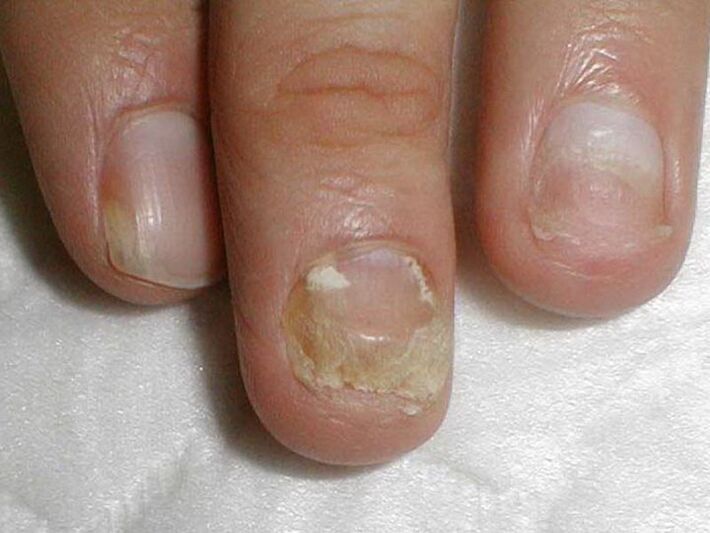
Treatment of candida fungus on the nails of the hands and feet with damage to more than half of the nail plate area, as in the picture, includes not only the fight against onychomycosis, but also measures to reduce candid activityin the natural reservoirs of their storage - intestines, oral cavity, genital mucosa. . .
Infection by molds
Molds cause fungi much less frequently than Candida or dermatophytes. The main symptom of toenail fungus infection is, as you can see in the picture, inchanging the color of the nail plate to blue, black, green.
Signs of toenail fungus can be dark spots, dots on the nail plate or, as in the picture, a black longitudinal stripe.
Preparations against fungi
Antifungal agents with fluconazole, ketoconazole, terbinafine, itraconazole, griseofulvin are used to treat nail fungus caused by dermatophytes, as shown in this picture.
Terbinafine antifungal agents are effective for dermatophyte infections.
Voriconazole antifungal agents are very active against dermatophytes.
andto treat nail funguson feet, hands andagainst candidate yeast. The spectrum of action includes forms such as Aspergillum, Fusarium, Penicillium.
Itraconazole-based preparations face forms.
Nail diseases like fungus
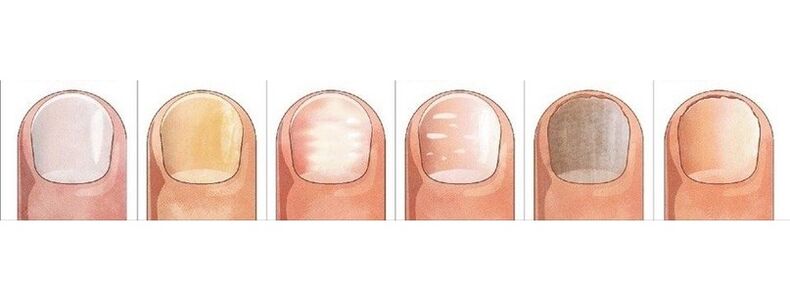
A gray tingesometimes appears on the nailwith eczema. In this case, the nail plate can be removed from the nail bed, which is observed with a fungus.
Externally it looks very similar to onychomycosismanifestations of psoriasis. With this disease, not onlychanges color, but alsothickened nail plates.
Point depressions are found on its surface, the separation of the nail plate from the nail bed is noticed. But there are differences from the fungus: in psoriasis, the detached and healthy parts of the toenails are separated by a pink, yellow band over time.
Bluish colorgets the nailwith pseudomonas nail infection. Frequent mechanical rubbing of the nail fold causes the appearance of surface grooves, wavy nail.
White spots of leukonia, the appearance of whichis associated with metabolic disorders, can also be mistaken for a superficial white fungus with a large spot area.
Changes in color, nail shape causing damage. The big toes are at greater risk. The nail with a lesion, as well as with a fungus, thickens and darkens.

The difference between injury and fungus is that changes during injury are noted only on the injured finger, the nails on the other fingers remain unchanged, are not infected by the diseased finger, as in onychomycosis.
The consequence of trauma may be a partial separation of the nail from the nail bed, the formation of a cavity, which, under adverse conditions, is rapidly colonized by the fungus.
Nail plate can separate from the nail bed under the influence of light (photonicolysis), with iron deficiency anemia, hormonal diseases. Separation, nail loss occurs with lichen erythematosus, bullous dermatoses, nail trauma.
But you can finally make sure the conclusion is correct and start treatment only after seeking help from a dermatologist - a dermatologist, or a mycologist - a doctor treating fungal diseases.





























